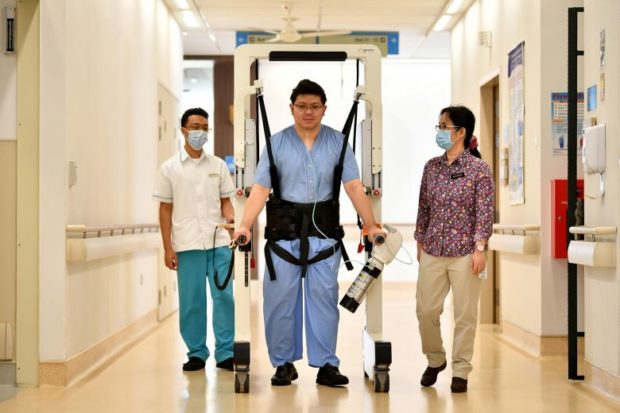COVID-19 patient gets back on his feet with help of robotic device

Dr Tay San San (right) and therapy assistant Muhammad Iylia Razalee (left), with a staff member demonstrating the use of the robotic walking aid, called Andago, which is primarily used for stroke patients. The Straits Times/Asia News Network/LIM YAOHUI
SINGAPORE — In his 61 years, Mr Tan had never been hospitalized – until he contracted the coronavirus in March and stayed at Changi General Hospital (CGH) for 44 days.
The retired businessman, who declined to give his full name, had gone to CGH with a fever, dry cough and breathlessness. The next day, his condition worsened into acute respiratory distress syndrome.
His lungs were inflamed and starved of oxygen, and he had to be intubated and hooked up to a mechanical ventilator for 15 days in the intensive care unit (ICU).
After his lungs got better and he no longer needed a ventilator, his doctor got him a chair so he would not be confined to the bed, and newspapers to keep him occupied.
Mr Tan thought the worst was over and that he could return home soon. But when he stood on his feet for the first time in 15 days, he was shocked to learn that he could not balance or walk without support.
“He lost 12kg, and the muscles in his legs had shrunk,” said Dr Tay San San, chief and senior consultant at CGH’s department of rehabilitation medicine.
To get Mr Tan back on his feet, Dr Tay brought in a robotic walking aid, called Andago, which is primarily used for stroke patients.
The smart robotic device is strapped to a patient, and bears part of his weight as he walks and strengthens his limbs.
Led by the patient, it matches his pace and stops when its sensors detect walls or barriers in front of the patient.
If the patient buckles, the harness will be automatically tightened so that his knees will not hit the ground. A chair can be placed between the device if he needs to rest.
A canister can be strapped to the device as well if a patient needs oxygen support.
Mr Tan was the first of three Covid-19 patients who were sent to the ICU to use Andago.
CGH rolled out Andago in June last year and it has benefited 244 patients so far.
Dr Tay noted that being bed-bound will cause muscle loss each day. “The body metabolizes the muscle, and that leads to weakness,” she added.
Mr Tan had to undergo 13 days of pulmonary rehabilitation, which includes physical exercise, breathing exercises and education, at the Integrated Building at CGH, which houses the hospital’s rehabilitation wards.
While supported by therapists during his first physiotherapy session, he could walk only 4m before his oxygen level plummeted and he became fatigued.
In his first session with Andago, which was developed by a Swiss company, Mr Tan clocked 302m with one break and some oxygen support, said Dr Tay.
Mr Tan told The Straits Times: “When I walked with Andago, I felt lighter (due to the weight support), and I felt more secure, and more confident. I knew I would not fall or be out of breath.”
By his sixth session with the device, he was able to walk 368m without oxygen support.
When he was discharged in May on Day 44, he was able to independently walk 142m slowly from the hospital to the car.
“I had already gone through ICU, which was the most difficult part. I had to push myself to walk again and get discharged,” said Mr Tan.
He said he did not know how he got Covid-19, and he did not travel.
While he did not feel much pain while battling the virus in the ICU, it took a toll on his mental well-being.
“Unable to move and (stuck) with the same sight and sounds of the ICU for two weeks, I felt I was going crazy. I kept having nightmares and was unable to sleep,” he said. “I was worried that once I fell asleep, I would not be able to wake up.”
Now, Mr Tan is in the pink of health, and daily 6km walks and breathing exercises have become part of his routine.
He has also resumed more strenuous workouts such as push-ups, sit-ups and dumb-bell lifting.
For more news about the novel coronavirus click here.
What you need to know about Coronavirus.
For more information on COVID-19, call the DOH Hotline: (02) 86517800 local 1149/1150.
The Inquirer Foundation supports our healthcare frontliners and is still accepting cash donations to be deposited at Banco de Oro (BDO) current account #007960018860 or donate through PayMaya using this link.